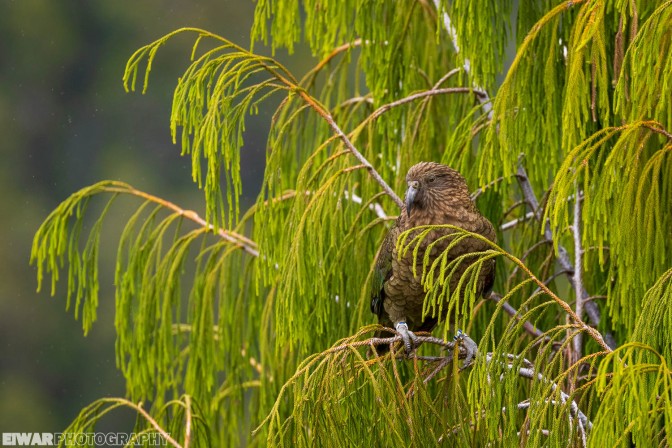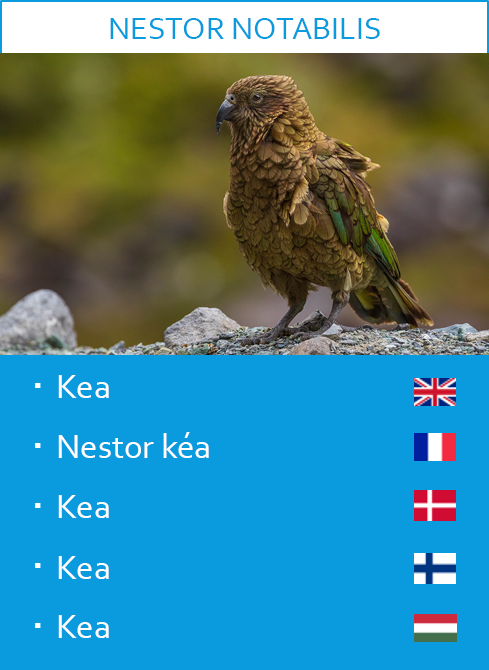You saw that one coming, didn’t you? In November, I presented you the Kaka (Nestor meridionalis), a smart parrot that I had encountered in Zealandia. I called the article “Kakacophony”, and told you I already knew the title of the article I would devote to its close relative, the Kea (Nestor notabilis). It took me a bit of traveling to put together a nice portfolio, but here we are: behold the Kea, a species endemic to the Southern Alps of New Zealand, and the only alpine parrot in the world.

With penguins, albatrosses and of course kiwi, kea were one of the birds I absolutely wanted to see in New Zealand. I think they are one of the most famous New Zealand birds for people who’ve never travelled here. Being the only parrot to live in mountains above the tree line, being very smart and curious, they have a special aura. They are known to love rubber, which they happily pick from cars to chew on. They are known to destroy tents and steal all kinds of things left unattended by hikers. There’s a word for that: cheeky. Kea are cheeky.
I was a bit afraid for my car, but I couldn’t wait to see that.
Like I mentioned in last week’s article, my encounter with this charismatic bird in Arthur’s Pass was disappointingly brief. I saw nothing of what was advertised on the area’s website. Sure, one bird landed on my car at the Otira lookout, but it wandered around for 5 minutes and then left. A few flew over the valley, but that was it.
I was looking forward to seeing them in Fjordland, but I first stumbled about some of these birds in Okarito, on the West Coast, when I expected them the least. It was an amazing moment. Okarito is better known for its kiwi, the Okarito kiwi (Apteryx rowi), and for New Zealand fernbirds (Poodytes punctatus). However, at the top of the Pakihi walk, on the viewing platform, a group of 5 Kea messed around, interacting with each other or with the couple that came before me.




I was a bit afraid that, if I focused on one of the birds, another would try to inspect my backpack, but luckily it did not happen. However, the morning after, when I handed them a blade of grass, they grew even more curious, and we had a funny game of tug-o-war together, which I tried to capture with my phone (you can see I was not very successful, but it gives you an idea of the proximity).




There’s something in these birds’ demeanour, maybe the way they hop around, or their funny call, that always brought a big smile on my face!
A few days later, in Fjordland, I finally saw them chew on car rubber. I was at the Homer Tunnel, at about 900m above sea level. There’s a large car park, and the kea are known to be around, ever curious about human visitors. They walk, they hop, they shout… and they jump on cars, trying to get a bite off window edges, windshield wipers or antennas!




Like in Okarito, the proximity was amazing. They are not so many birds left in New Zealand, but more often than not, you can see them at very close range. Kea are no exception, they may well be the most familiar after the robins, but that can play tricks on them.
To get rid of introduced predators (rats, stoats…) that threaten native species, poison is regularly spread in the New Zealand countryside. It comes in the form of colourful cereal baits, a solution that signals to most birds that it’s not edible. Generally, the impact on local birds is negligible. However, when treating an alpine habitat, special care has to be taken, because kea will find these colourful baits very interesting, will ingest them and die! Funny enough, it’s another introduced species, the Himalayan thar (Hemitragus jemlahicus), an ungulate from the Himalaya, that can save them. Rangers have found that, if the carcass of a thar was lain close to poison baits, kea will find it more interesting and will not eat the poison.
This sounds funny, but for me it’s also sad. It shows how much unnatural trickery has to be used in order to save what’s left of New Zealand’s native wildlife.

Before going to Fjordland, I had this idea of a Kea shot in its environment, an image made with a wide-angle lens to capture the habitat around. I knew I could get very close to these birds, but they are not always poser; it’s as if they really enjoy jumping away just when I take the picture. Fortunately, one stayed long enough to show off in the place it calls home, the majestic mountains of the South Island.



****
Follow me! Newsletter, Facebook, Instagram, Twitter… you name it!
Want to know where I am? Check out the map!
Want to support me? Buy a print!
****


Really cool pics! Some of the green feather coloration reminds of us our little parrot & the hopping reminds us of how Caiques hop.
LikeLiked by 1 person
Tes photos où on peut voir le détails des plumes sont superbes ! J’aime beaucoup celle de couverture également !
LikeLiked by 1 person
Merci Jérôme 🙂
LikeLiked by 1 person
I saw albatrosses and even a green-eyed penguin close up, but in the Milford sound: no kiwis!!!!!
I was a little disappointed, so I enjoyed your encounter with the Kiwis all the more! Especially your videos 😊
LikeLike
Of course I meant yellow-eyed penguins…
LikeLike